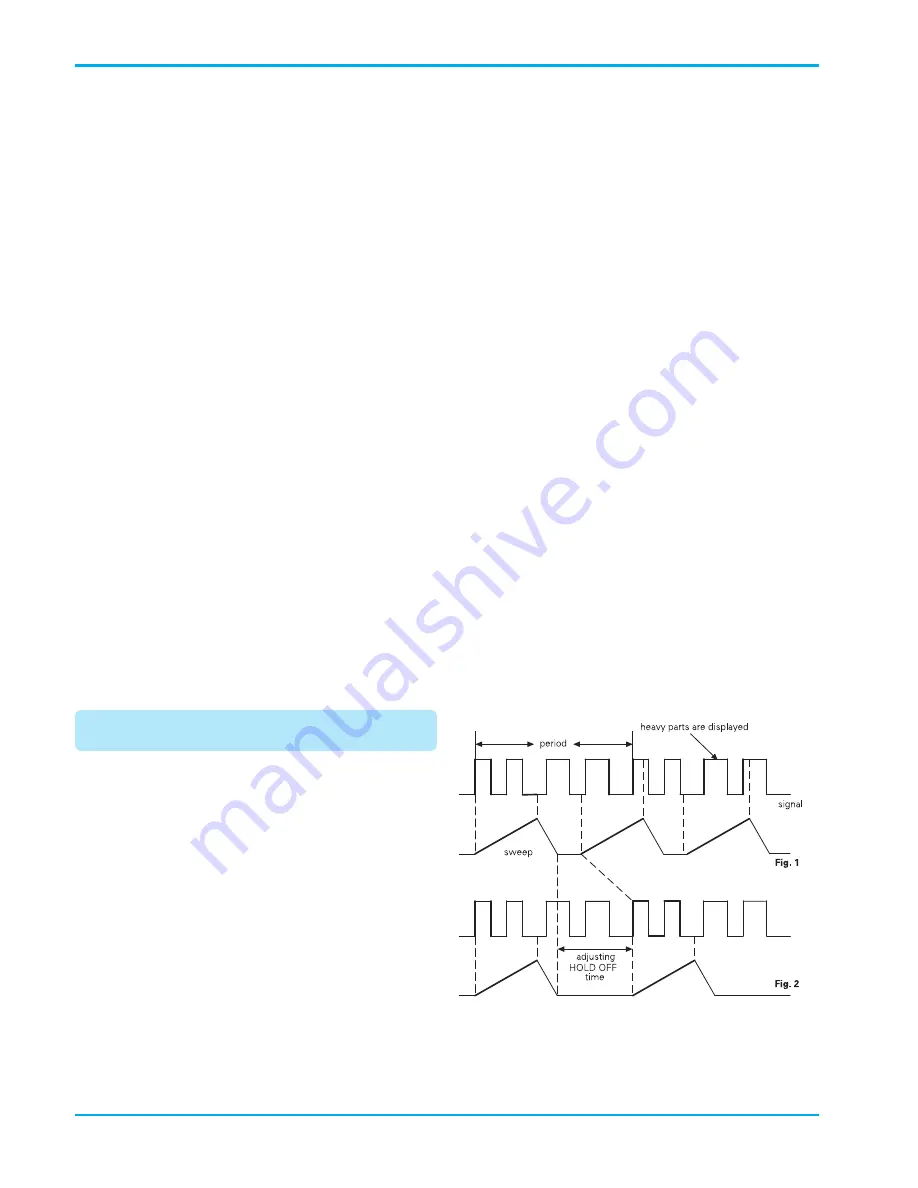
Subject to change without notice
28
met (
please note “Controls and Readout”
). In the case of
chopped DUAL mode, selecting alternate trigger mode
automatically sets the instrument to alternate DUAL mode. The
trigger point symbol and the peak value detection (in automatic
trigger mode) are internally deactivated. Only the following trigger
coupling modes are available in alternate trigger mode: AC, DC,
NR, HF and LF.
With alternate triggering it is possible to trigger two signals which
are different in frequency (asynchronous). Each input signal must
be of sufficient height to enable trigger. To avoid trigger problems
due to different DC voltage components, AC input coupling for
both channels is recommended.
The internal trigger source is switched in alternate trigger mode
in the same way as the channel switching system in DUAL
alternate mode, i.e. after each time base sweep. Phase difference
measurement is not possible in this trigger mode as the trigger
level and slope setting are equal for both signals. Even with 180°
phase difference between both signals, they appear with the
same slope direction. If signals are applied with a high frequency
ratio (difference), the trace intensity then becomes reduced if
the time base is set to smaller time coefficients (faster sweep).
This happens as the number of sweeps does not increase
because it depends on the lower frequency signal, but with a
faster sweep the phosphor becomes less activated.
External triggering
The external trigger input is activated with the aid of the
TRIG.
(20)
pushbutton (
see “Controls and Readout”
), if the trigger
coupling is not set to line/mains trigger coupling. Then the internal
trigger source is deactivated.
As the external trigger signal applied at the TRIG. EXT socket
normally has no relation to the signal height of the displayed
signal, the trigger point symbol is switched off. The external
trigger voltage must have a minimum amplitude of 0.3V
pp
and
should not increase above 3V
pp
. The input impedance of the
TRIG. EXT. socket is approx. 1M
Ω
II 20pF.
The maximum input voltage of the input circuit is 100V
(DC+peak AC).
The external trigger voltage may have a completely different form
from the test signal voltage, but must be synchronous with the
test signal. Triggering is even possible in certain limits with whole
number multiples or fractions of the test frequency.
It must be noted that a different phase angle between the
measuring and the triggering signal may cause a display not
coinciding with the slope selection setting.
The trigger coupling selection can also be used in external
triggering mode.
Trigger indicator “TR”
The following description applies to the
“TR” LED
.
Please note
item (14) under “Controls and Readout”
.
An LED on condition indicates that the trigger signal has a
sufficient amplitude and the trigger level control setting is correct.
This is valid with automatic and with normal triggering. By
observing the trigger LED, sensitive trigger level adjustment is
possible when normal triggering is used, particularly at very low
signal frequencies. The indication pulses are of only 100ms
duration.
Thus for fast signals the LED appears to glow continuously, for
low repetition rate signals, the LED flashes at the repetition rate
or at a display of several signal periods not only at the start of
the sweep at the left screen edge, but also at each signal period.
In automatic triggering mode the sweep generator starts
repeatedly without test signal or external trigger voltage. If the
trigger signal frequency decreases the trigger automatic
repetition frequency the sweep generator starts without awaiting
the trigger pulse. This causes an untriggered display and a flashing
trigger LED.
HOLD OFF-time adjustment
For instrument specific information
please note DEL.POS. - HO
(24) in section “Controls and Readout”
.
If it is found that a trigger point cannot be found on extremely
complex signals, even after careful adjustment of the trigger level
control, a stable display may often be obtained using the holdoff
control. This facility varies the holdoff time between two sweep
periods approx. up to the ratio 10:1. Pulses or other signal
waveforms appearing during this off period cannot trigger the
time base. Particularly with burst signals or aperiodic pulse trains
of the same amplitude, the start of the sweep can be delayed
until the optimum or required time.
A very noisy signal or a signal with a higher interfering frequency
is at times displayed double. It is possible that trigger level
adjustment only controls the mutual phase shift, but not the
double display. The stable single display of the signal, required
for evaluation, is easily obtainable by expanding the hold off time
until one signal is displayed.
A double display is possible with certain pulse signals, where
the pulses alternately show a small difference of the peak
Triggering and Time Base
Fig. 1 shows a case where the holdoff control is in the minimum
position and various different waveforms are overlapped on
the screen, making the signal observation unsuccessful.
Fig. 2 shows a case where only the desired parts of the signal are
stably displayed.









































